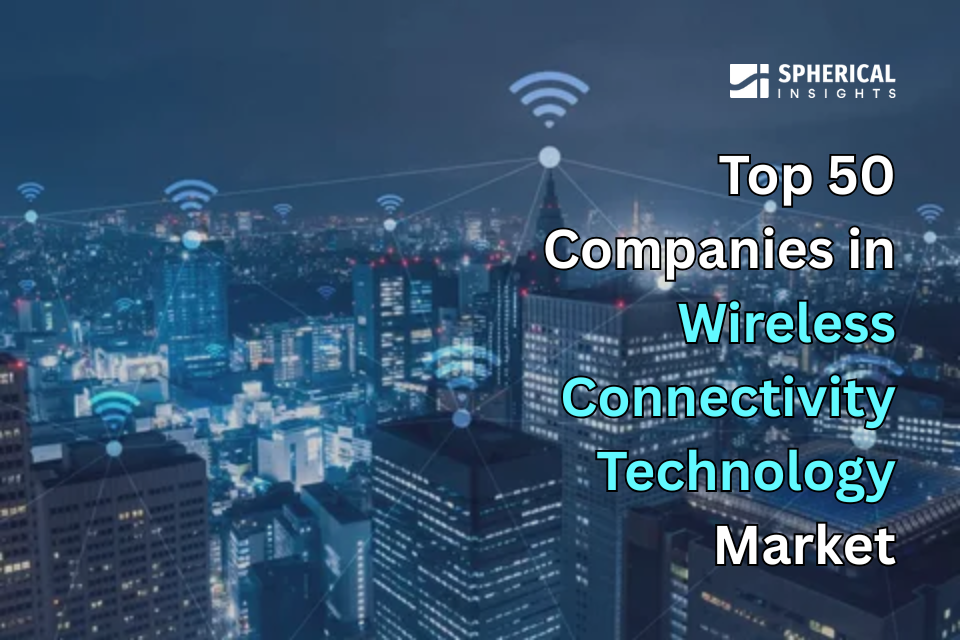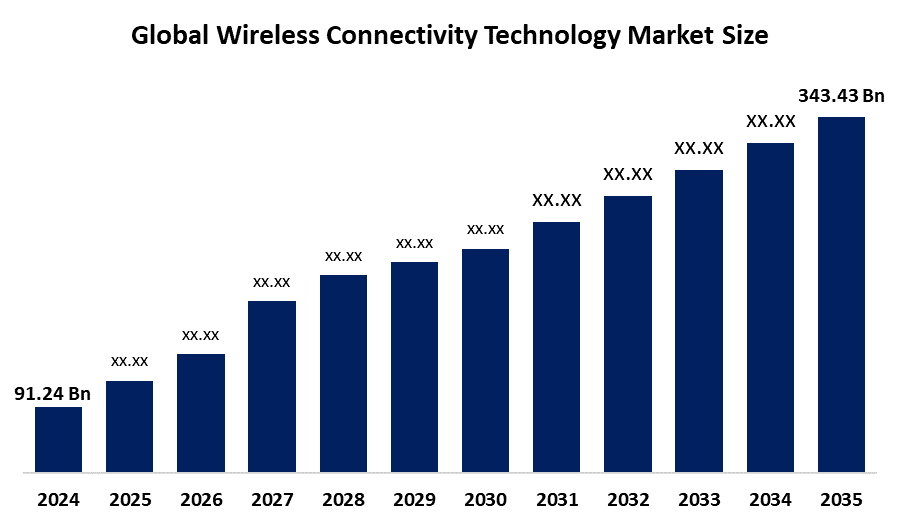
Top 50 Companies in Wireless Connectivity Technology Market: Key Insights & Innovations (2024–2035)
RELEASE DATE: Aug 2025 Author: Spherical InsightsRequest Free Sample Speak to Analyst
Description
According to a research report published by Spherical Insights & Consulting, The Global Wireless Connectivity Technology Market Size is projected to Grow from USD 91.24 Billion in 2024 to USD 343.43 Billion by 2035, at a CAGR of 12.81% during the forecast period 2025–2035. Human and material resources must be connected for metropolitan areas to become smart cities globally. Connectivity has changed throughout time, moving from wired to wireless. Additionally, because wireless networks are widely used in smart infrastructures, the market is expected to grow as a result of the advancement of wireless connections, which has increased the data transfer rate.
Introduction
The networking technology known as wireless connectivity allows two nodes or devices to be connected without the use of wires, cables, or cords. With wireless communication, users may connect devices and systems without having to spend a lot of money installing cables throughout a structure. Businesses find it harder to stay competitive if they don't implement technology, such as a reliable wireless network. Employees can move about the office without losing access to the company network due to wireless connectivity. Meanwhile, all users can access the same critical information and apps on any device through the network. The widespread use of Wi-Fi as a wireless LAN connection in commercial, industrial, and residential contexts is driving demand for smart lighting that is Wi-Fi-enabled. Smart lighting in Wi-Fi-enabled infrastructure usually uses Wi-Fi connectivity. Furthermore, the spread of IoT-based technology in emerging nations is beneficial since it will open up new markets in the future. Smart lighting infrastructure also uses Bluetooth as a wireless connectivity technology. This wireless technology connects devices and gives people remote access.
Navigate Future Markets with Confidence: Insights from Spherical Insights LLP
The insights presented in this blog are derived from comprehensive market research conducted by Spherical Insights LLP, a trusted advisory partner to leading global enterprises. Backed by in-depth data analysis, expert forecasting, and industry-specific intelligence, our reports empower decision-makers to identify strategic growth opportunities in fast-evolving sectors. Clients seeking detailed market segmentation, competitive landscapes, regional outlooks, and future investment trends will find immense value in the full report. By leveraging our research, businesses can make informed decisions, gain a competitive edge, and stay ahead in the transition toward sustainable and profitable solutions.
Unlock exclusive market insights-Download the Brochure now and dive deeper into the future of the Wireless Connectivity Technology Market.
Wireless Connectivity Technology Market Size & Statistics
The Market Size for Wireless Connectivity Technology Was Estimated to be worth USD 91.24 Billion in 2024.
The Market Size is Going to Expand at a CAGR of 12.81% between 2025 and 2035.
The Global Wireless Connectivity Technology Market Size is anticipated to reach USD 343.43 Billion by 2035.
North America is expected to generate the highest demand during the forecast period in the Wireless Connectivity Technology Market
Asia Pacific is expected to grow the fastest during the forecast period in the Wireless Connectivity Technology Market.

Regional growth and demand
Asia Pacific is expected to grow the fastest during the forecast period in the wireless connectivity technology market. Consumer electronics are dominating the Asia-Pacific industry due to their rising affordability, which promotes long-term investments in the sector. The wireless connectivity technology sector also has a lot of room to grow as a result of the region's growing use of sports for medical diagnosis. Furthermore, the growing adoption of smart technologies in Asia-Pacific creates a profitable opportunity for market expansion in the area. Growth in the market is driven by the technological advancements of the expanding economies in Asia-Pacific. It is projected that regional growth will be impacted by the growing demand for consumer electronics such as smartphones and smart wearables.
North America is expected to generate the highest demand during the forecast period in the wireless connectivity technology market. North America's technological innovations, investments, and improvements in the wireless connectivity sector have increased market demand, making it a significant contributor to the worldwide market's growth. The growing popularity of portable technologies for a range of applications in North America is responsible for the growth of the wireless connectivity technology market in the area. Additionally, the government's increasing investment and the growing use of smartphones and smart wearables are factors driving the growth of the wireless communication technology sector.
Top 10 trends in the Wireless Connectivity Technology Market
- Wi-Fi 7 and Wi-Fi 6E adoption
- Expansion and deployment of 5G networks
- Emergence of 6G research and piloting
- AI and machine learning integration
- Proliferation of Internet of Things (IoT)
- Edge computing expansion
- Low-power wide-area networks (LPWAN) for IoT
- Network-as-a-Service (NaaS) models
- Growth of private and enterprise wireless networks
- Focus on cybersecurity and data privacy
1. Wi-Fi 7 and Wi-Fi 6E adoption
Wi-Fi 7 and Wi-Fi 6E standards introduce faster speeds, lower latency, and higher capacity, supporting dense device environments in homes and enterprises. These technologies enable real-time applications such as video streaming, remote diagnostics, and smart automation with multi-gigabit wireless performance.
2. Expansion and deployment of 5G networks
Rapid rollout of 5G is transforming wireless connectivity by enabling ultra-reliable, low-latency connections and high-data-rate communications for mobile broadband, enterprise solutions, and industrial automation. This supports growth in connected devices and smart infrastructure.
3. Emergence of 6G research and piloting
6G represents the next leap in wireless innovation, promising up to 1 terabit per second speeds, ultra-low latency, and deep AI integration for autonomous network operations. Early-stage pilots aim to support new paradigms like seamless machine-to-machine communication and immersive experiences.
4. AI and machine learning integration
Artificial Intelligence is enabling adaptive, self-healing wireless networks, automated optimization, enhanced spectrum management, and intelligent security measures. AI integration improves user experience, network reliability, and operational efficiency in increasingly complex environments.
5. Proliferation othe f Internet of Things (IoT)
The rapid growth of IoT devices is creating demand for robust, scalable wireless networks. IoT relies on varied connectivity, from Wi-Fi to LPWAN, to support applications in smart homes, manufacturing, transportation, and healthcare, driving continuous innovation in wireless solutions.
Empower your strategic planning:
Stay informed with the latest industry insights and market trends to identify new opportunities and drive growth in the wireless connectivity technology market. To explore more in-depth trends, insights, and forecasts, please refer to our detailed report.
Top 25 Companies Leading the Wireless Connectivity Technology Market
- Qualcomm
- Huawei
- Cisco Systems
- Ericsson
- Nokia
- Samsung Electronics
- Intel Corporation
- Broadcom Inc.
- ZTE Corporation
- MediaTek
- Ciena Corporation
- Juniper Networks
- Arista Networks
- CommScope
- Extreme Networks
- Harman International
- FogHorn Systems
- Radisys Corporation
- Cradlepoint
- Airthings
- Telit Communications
- CalAmp
- Mimosa Networks
- Silicon Labs
- Casa Systems
1. Qualcomm
Headquarters: San Diego, California, USA
Qualcomm is a global leader in wireless connectivity technology, pioneering advancements from 3G and 4G to the latest 5G and Wi-Fi 7 innovations. Known for its foundational patents and semiconductor expertise, Qualcomm powers a vast ecosystem of mobile devices, IoT solutions, automotive connectivity, and next-generation wireless infrastructure. The company’s wireless connectivity portfolio features high-speed, low-latency chipsets and AI-enhanced networking, enabling robust performance across smartphones, smart homes, and industrial applications. As a driver of Wi-Fi 7, 5G, and edge intelligence, Qualcomm continues to shape the future of wireless networks, setting industry standards in speed, scalability, and security in the evolving wireless connectivity technology market.
2. Huawei
Headquarters: Shenzhen, China
Huawei is a powerhouse in the wireless connectivity technology sector, renowned for its industry-leading 5G networks, advanced microwave solutions, and AI-driven cloud platforms. The company supports telecom operators and enterprises worldwide with robust infrastructure, including base stations, private wireless networks, and integrated IoT frameworks. Huawei’s wireless technology enables ultra-fast, reliable, and secure communications for smart cities, transportation, and rural broadband. Through sustained R&D investment, Huawei actively contributes to 5G deployment, 6G research, and the expansion of the global wireless ecosystem, positioning itself as a top innovator amid the increasing demand for seamless, scalable wireless connectivity solutions.
3. Cisco Systems
Headquarters: San Jose, California, USA
Cisco Systems is a dominant force in wireless connectivity, shaping enterprise and carrier networks with secure, scalable, and resilient wireless and cloud solutions. The company’s innovations include industry-standard routing, Wi-Fi 6/6E access points, network automation, and integrated AI/ML-powered management tools. Cisco enables robust coverage for mobile workforces, smart buildings, and IoT deployments, delivering cloud-managed networking and full-stack security for digital transformation. As wireless connectivity expands to edge computing and hybrid environments, Cisco’s relentless focus on cybersecurity, interoperability, and intelligent automation ensures it remains a top choice for businesses seeking future-ready wireless infrastructure.
4. Ericsson
Headquarters: Stockholm, Sweden
Ericsson is a global front-runner in wireless technology, renowned for pioneering mobile infrastructure from 2G to 5G and ongoing innovation toward 6G. With a client base in over 180 countries, Ericsson delivers cutting-edge radio access networks, core systems, and cloud-native solutions for telecom operators and private enterprise networks. The company leads in network slicing, low-latency industrial connectivity, and managed wireless services, powering everything from national broadband to mission-critical IoT. Ericsson’s commitment to R&D, open standards, and sustainable solutions underpins its leadership in the wireless connectivity technology market, supporting the evolution of next-generation digital ecosystems.
5. Nokia
Headquarters: Espoo, Finland
Nokia is a top innovator in wireless connectivity technology, supplying comprehensive solutions spanning private industrial wireless, public 5G, and fixed networks. Its Digital Automation Cloud and Modular Private Wireless portfolio offer flexible, secure, and low-latency connectivity for sectors like manufacturing, energy, and logistics. With deep experience in radio systems, network security, and IoT integration, Nokia drives transformation in both enterprise and public network spaces. The company leads 5G deployments globally and is actively involved in 6G research, with a strong focus on sustainability, automation, and digital transformation through advanced wireless infrastructure.
Are you ready to discover more about the wireless connectivity technology market?
The report provides an in-depth analysis of the leading companies operating in the global wireless connectivity technology market. It includes a comparative assessment based on their product portfolios, business overviews, geographical footprint, strategic initiatives, market segment share, and SWOT analysis. Each company is profiled using a standardized format that includes:
Company Profiles
- Qualcomm
- Business Overview
- Company Snapshot
- Products Overview
- Company Market Share Analysis
- Company Coverage Portfolio
- Financial Analysis
- Recent Developments
- Merger and Acquisitions
- SWOT Analysis
- Huawei
- Cisco Systems
- Ericsson
- Nokia
- Samsung Electronics
- Intel Corporation
- Broadcom Inc.
- ZTE Corporation
- Others.
Conclusion
The wireless connectivity technology market is rapidly advancing, driven by new standards like Wi-Fi 7 and fast 5G expansion, alongside rising IoT adoption and demand for reliable, high-speed communication. Leading companies such as Qualcomm, Huawei, Cisco Systems, Ericsson, and Nokia continue to innovate, shaping the industry with breakthroughs in AI-driven networks, edge computing, and secure, scalable infrastructure. As enterprises, consumers, and smart devices grow more interconnected, ongoing investment in R&D, focus on security, and commitment to seamless user experiences will define future progress.
About the Spherical Insights & Consulting
Spherical Insights & Consulting is a market research and consulting firm which provides actionable market research study, quantitative forecasting and trends analysis provides forward-looking insight especially designed for decision makers and aids ROI.
Which is catering to different industry such as financial sectors, industrial sectors, government organizations, universities, non-profits and corporations. The company's mission is to work with businesses to achieve business objectives and maintain strategic improvements.
CONTACT US:
For More Information on Your Target Market, Please Contact Us Below:
Phone: +1 303 800 4326 (the U.S.)
Phone: +91 90289 24100 (APAC)
Email: inquiry@sphericalinsights.com, sales@sphericalinsights.com
Contact Us: https://www.sphericalinsights.com/contact-us
Need help to buy this report?